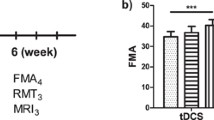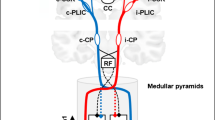Abstract
Changes in diffusion tensor imaging (DTI) values co-occur with neurological and functional changes after stroke. However, quantitative DTI metrics have not been examined in response to participation in targeted rehabilitative interventions in chronic stroke. The primary purpose of this pilot study was to examine whether changes in DTI metrics co-occur with paretic arm movement changes among chronic stroke patients participating in a regimen of electrical stimulation targeting the paretic arm. Three subjects exhibiting stable arm hemiparesis were administered 30-minute (n = 1) or 120-minute (n = 2) therapy sessions emphasizing paretic arm use during valued, functional tasks and incorporating an electrical stimulation device. These sessions occurred every weekday for 8 weeks. A fourth subject served as a treatment control, participating in a 30-minute home exercise regimen without electrical stimulation every weekday for 8 weeks. DTI and behavioral outcome measures were acquired at baseline and after intervention. DTI data were analyzed using a region of interest (ROI) approach, with ROIs chosen based on tract involvement in sensorimotor function or as control regions. Behavioral outcome measures were the Fugl-Meyer Scale (FM) and the Action Research Arm Test (ARAT). The treatment control subject exhibited gains in pinch and grasp, as shown by a 5-point increase on the ARAT. The subject who participated in 30-minute therapy sessions exhibited no behavioral gains. Subjects participating in 120-minute therapy sessions displayed consistent impairment reductions and distal movement changes. DTI changes were largest in subjects two and three, with mean diffusivity (MD) decreases in the middle cerebellar peduncle and posterior limb of the internal capsule following treatment. No changes in fractional anisotropy (FA) were observed for sensorimotor tracts. Our preliminary results suggest that active rehabilitative therapies augmented by electrical stimulation may induce positive behavioral changes which are underscored by DTI changes indicative of increased white matter tract integrity in regions specific to sensory-motor function.




Similar content being viewed by others
References
Alexander, A. L., Lee, J. E., Lazar, M., & Field, A. S. (2007). Diffusion tensor imaging of the brain. Neurotherapeutics, 4, 316–329.
Alon, G., Levitt, A. F., & McCarthy, P. A. (2007). Functional electrical stimulation enhancement of upper extremity functional recovery during stroke rehabilitation: a pilot study. Neurorehabilitation and Neural Repair, 21, 207–215.
Assaf, Y., & Pasternak, O. (2008). Diffusion tensor imaging (DTI)-based white matter mapping in brain research: a review. Journal of Molecular Neuroscience, 34, 51–61.
Basser, P. J., & Pierpaoli, C. (1996). Microstructural and physiological features of tissues elucidated by quantitative-diffusion-tensor MRI. Journal of Magnetic Resonance. Series B, 111, 209–219.
Bohannon, R. W., & Smith, M. B. (1987). Interrater reliability of a modified ashworth scale of muscle spasticity. Physical Therapy, 67, 206–207.
Catani, M., & Mesulam, M. (2008). What is a disconnection syndrome? Cortex, 44, 911–913.
Choi, J. Y., Lee, K. H., Na, D. L., et al. (2007). Subcortical aphasia after striatocapsular infarction: quantitative analysis of brain perfusion SPECT using statistical parametric mapping and a statistical probabilistic anatomic map. Journal of Nuclear Medicine, 48, 194–200.
Cox, R. W. (1996). AFNI: Software for analysis and visualization of functional magnetic resonance neuroimages. Computers and Biomedical Research, 29, 162–173.
Di Fabio, R. P., & Badke, M. B. (1990). Relationship of sensory organization to balance function in patients with hemiplegia. Physical Therapy, 70, 542–548.
Duncan, P. W., Propst, M., & Nelson, S. G. (1983). Reliability of the fugl-meyer assessment of sensorimotor recovery following cerebrovascular accident. Physical Therapy, 63, 1606–1610.
Dunning, K., Berberich, A., Albers, B., et al. (2008). A four-week, task-specific neuroprosthesis program for a person with no active wrist or finger movement because of chronic stroke. Physical Therapy, 88, 397–405.
Fugl-Meyer, A. R., Jaasko, L., Leyman, I., Olsson, S., & Steglind, S. (1975). The post-stroke hemiplegic patient. 1. a method for evaluation of physical performance. Scandinavian Journal of Rehabilitation Medicine, 7, 13–31.
Ghazni, N. F., Cahill, C. M., & Stroman, P. W. (2009). Tactile sensory and pain networks in the human spinal cord and brain stem mapped by means of functional MR imaging. AJNR Am J Neuroradiol.
Hsieh, C. L., Hsueh, I. P., Chiang, F. M., & Lin, P. H. (1998). Inter-rater reliability and validity of the action research arm test in stroke patients. Age and Ageing, 27, 107–113.
Jang, S. H., Cho, S. H., Kim, Y. H., et al. (2005). Diffusion anisotrophy in the early stages of stroke can predict motor outcome. Restorative Neurology and Neuroscience, 23, 11–17.
Jones, D. K., Horsfield, M. A., & Simmons, A. (1999). Optimal strategies for measuring diffusion in anisotropic systems by magnetic resonance imaging. Magnetic Resonance in Medicine, 42, 515–525.
Judith, D. S. (2004). Motor rehabilitation and brain plasticity after hemiparetic stroke. Progress in Neurobiology, 73, 61–72.
Kamran, S., Bates, V., Bakshi, R., Wright, P., Kinkel, W., & Miletich, R. (2000). Significance of hyperintense vessels on FLAIR MRI in acute stroke. Neurology, 55, 265–269.
Lai, S. M., Duncan, P. W., Dew, P., & Keighley, J. (2005). Sex differences in stroke recovery. Preventing Chronic Disease, 2, A13.
Lee, J. H., Garwood, M., Menon, R., et al. (1995). High contrast and fast three-dimensional magnetic resonance imaging at high fields. Magnetic Resonance in Medicine, 34, 308–312.
Lotze, M., Braun, C., Birbaumer, N., Anders, S., & Cohen, L. G. (2003). Motor learning elicited by voluntary drive. Brain, 126, 866–872.
Lyle, R. C. (1981). A performance test for assessment of upper limb function in physical rehabilitation treatment and research. International Journal of Rehabilitation Research, 4, 483–492.
Mamata, H., Jolesz, F. A., & Maier, S. E. (2004). Characterization of central nervous system structures by magnetic resonance diffusion anisotropy. Neurochemistry International, 45, 553–560.
Medical Neurosciences Unit 2: Brainstem. Available at: http://www.neuroanatomy.wisc.edu/virtualbrain/BrainStem/16Pontine.html. Accessed August 25, 2011, 2011.
Melhem, E. R., Mori, S., Mukundan, G., Kraut, M. A., Pomper, M. G., & van Zijl, P. C. (2002). Diffusion tensor MR imaging of the brain and white matter tractography. AJR. American Journal of Roentgenology, 178, 3–16.
Moller, M., Frandsen, J., Andersen, G., Gjedde, A., Vestergaard-Poulsen, P., & Ostergaard, L. (2007). Dynamic changes in corticospinal tracts after stroke detected by fibretracking. Journal of Neurology, Neurosurgery, and Psychiatry, 78, 587–592.
Mulder, T., Zijlstra, W., & Geurts, A. (2002). Assessment of motor recovery and decline. Gait & Posture, 16, 198–210.
Murata, Y., Yamaguchi, S., Kawakami, H., et al. (1998). Characteristic magnetic resonance imaging findings in machado-joseph disease. Archives of Neurology, 55, 33–37.
Page, S. J., Levine, P., & Leonard, A. C. (2005). Effects of mental practice on affected limb use and function in chronic stroke. Archives of Physical Medicine and Rehabilitation, 86, 399–402.
Page, S. J., Maslyn, S., Hermann, V. H., Wu, A., Dunning, K., & Levine, P. G. (2009). Activity-based electrical stimulation training in a stroke patient with minimal movement in the paretic upper extremity. Neurorehabilitation and Neural Repair, 23, 595–599.
Page, S. J., Harnish, S. M., Lamy, M., Eliassen, J. C., & Szaflarski, J. P. (2010). Affected arm use and cortical change in stroke patients exhibiting minimal hand movement. Neurorehabilitation and Neural Repair, 24, 195–203.
Page, S., Dunning, K., Hermann, V., Boyne, P., & Levine, P. (2010). Poster 80: optimal daily duration of repetitive task specific training incorporating electrical stimulation in moderately impaired stroke. Archives of Physical Medicine and Rehabilitation, 91, e29.
Paolucci, S., Antonucci, G., Grasso, M. G., et al. (2003). Functional outcome of ischemic and hemorrhagic stroke patients after inpatient rehabilitation: a matched comparison. Stroke, 34, 2861–2865.
Pierpaoli, C., Jezzard, P., Basser, P. J., Barnett, A., & Di Chiro, G. (1996). Diffusion tensor MR imaging of the human brain. Radiology, 201, 637–648.
Plautz, E. J., Milliken, G. W., & Nudo, R. J. (2000). Effects of repetitive motor training on movement representations in adult squirrel monkeys: role of use versus learning. Neurobiology of Learning and Memory, 74, 27–55.
Puig, J., Pedraza, S., Blasco, G., et al. (2010). Wallerian degeneration in the corticospinal tract evaluated by diffusion tensor imaging correlates with motor deficit 30 days after middle cerebral artery ischemic stroke. American Journal of Neuroradiology, 31, 1324–1330.
R Development Core Team. (2009). R: A language and environment for statistical computing. Vienna, Austria;2.10.1.
Radlinska, B., Ghinani, S., Leppert, I. R., Minuk, J., Pike, G. B., & Thiel, A. (2010). Diffusion tensor imaging, permanent pyramidal tract damage, and outcome in subcortical stroke. Neurology, 75, 1048–1054.
Reeves, M. J., Bushnell, C. D., Howard, G., et al. (2008). Sex differences in stroke: epidemiology, clinical presentation, medical care, and outcomes. Lancet Neurology, 7, 915–926.
Rohde, G. K., Barnett, A. S., Basser, P. J., Marenco, S., & Pierpaoli, C. (2004). Comprehensive approach for correction of motion and distortion in diffusion-weighted MRI. Magnetic Resonance in Medicine, 51, 103–114.
Saad, Z. S., Glen, D. R., Chen, G., Beauchamp, M. S., Desai, R., & Cox, R. W. (2009). A new method for improving functional-to-structural MRI alignment using local pearson correlation. NeuroImage, 44, 839–848.
Schmierer, K., Wheeler-Kingshott, C. A., Tozer, D. J., et al. (2008). Quantitative magnetic resonance of postmortem multiple sclerosis brain before and after fixation. Magnetic Resonance in Medicine, 59, 268–277.
Schmithorst, V. J., Dardzinski, B. J., & Holland, S. K. (2001). Simultaneous correction of ghost and geometric distortion artifacts in EPI using a multiecho reference scan. IEEE Transactions on Medical Imaging, 20, 535–539.
Strong, O., & Elwin, A. (1943). Human neuroanatomy. Baltimore: Williams and Wilkins.
Teng, E., & Chui, H. (1987). The modified mini-mental state (3MS) examination. The Journal of Clinical Psychiatry, 48, 314–318.
Thomalla, G., Glauche, V., Weiller, C., & Rother, J. (2005). Time course of wallerian degeneration after ischaemic stroke revealed by diffusion tensor imaging. Journal of Neurology, Neurosurgery, and Psychiatry, 76, 266–268.
Van der Lee, J. H., De Groot, V., Beckerman, H., Wagenaar, R. C., Lankhorst, G. J., & Bouter, L. M. (2001). The intra- and interrater reliability of the action research arm test: A practical test of upper extremity function in patients with stroke. Archives of Physical Medicine and Rehabilitation, 82, 14–19.
Watanabe, T., Honda, Y., Fujii, Y., Koyama, M., Matsuzawa, H., & Tanaka, R. (2001). Three-dimensional anisotropy contrast magnetic resonance axonography to predict the prognosis for motor function in patients suffering from stroke. Journal of Neurosurgery, 94, 955–960.
Weingarden, H. P., Zeilig, G., Heruti, R., et al. (1998). Hybrid functional electrical stimulation orthosis system for the upper limb: effects on spasticity in chronic stable hemiplegia. American Journal of Physical Medicine & Rehabilitation, 77, 276–281.
Werring, D. J., Toosy, A. T., Clark, C. A., et al. (2000). Diffusion tensor imaging can detect and quantify corticospinal tract degeneration after stroke. Journal of Neurology, Neurosurgery, and Psychiatry, 69, 269–272.
Woldag, H., & Hummelsheim, H. (2002). Evidence-based physiotherapeutic concepts for improving arm and hand function in stroke patients: a review. Journal of Neurology, 249, 518–528.
Wolf, S. L., Winstein, C. J., Miller, J. P., et al. (2006). Effect of constraint-induced movement therapy on upper extremity function 3 to 9 months after stroke: the EXCITE randomized clinical trial. Journal of the American Medical Association, 296, 2095–2104.
Yu, C., Zhu, C., Zhang, Y., et al. (2009). A longitudinal diffusion tensor imaging study on wallerian degeneration of corticospinal tract after motor pathway stroke. NeuroImage, 47, 451–458.
Acknowledgements
This study was supported by a grant from the American Heart Association, and a University of Cincinnati Research Council Grant.
Author information
Authors and Affiliations
Corresponding author
Rights and permissions
About this article
Cite this article
Boespflug, E.L., Storrs, J.M., Allendorfer, J.B. et al. Mean diffusivity as a potential diffusion tensor biomarker of motor rehabilitation after electrical stimulation incorporating task specific exercise in stroke: a pilot study. Brain Imaging and Behavior 8, 359–369 (2014). https://doi.org/10.1007/s11682-011-9144-1
Published:
Issue Date:
DOI: https://doi.org/10.1007/s11682-011-9144-1




